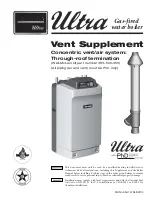
56
Steps to inspect, clean and/or replace control well:
1.
Turn off electric service to boiler controls.
2.
Drain boiler water to level below tapping for control
well.
3.
Remove low water cut-off/limit sensor from control
well.
4.
Unscrew control well from tapping.
5.
Inspect portion of control well exposed to water for
scale or sediment buildup.
6.
Light deposits may be removed by wiping control well
with damp cloth. Wiping probe with cloth soaked in
vinegar will remove more tenacious lime deposits.
7.
Clean pipe threads of probe to remove old, hardened
pipe dope and other foreign matter.
8.
Apply moderate amount of good quality pipe dope to
pipe threads on control well, leaving two end threads
bare. Do not use PTFE (Teflon) tape.
9.
Reinstall control well into tapping.
10.
Reinsert low water cutoff/limit sensor in control well
and secure with grommet.
11.
Fill system with water and purge.
12.
Restore electric service to boiler.
13.
Fire burner to heat water in boiler 180°F to drive off
free oxygen.
14.
Warning – before returning boiler to service: Follow
low water cut-off test procedure in
Figure 36, Page 43.
18.9 Boiler And System Cleaning Instructions
For Trouble Free Operation
1.
Boiler and system (other than expansion tank) must
be full of water for satisfactory operation. Add water
to system until boiler pressure gauge registers 12 psi.
Water should come out of all air vents when opened.
2.
Wash Oil and grease which accumulate in new hot
water boiler out in following manner:
•
Shut off valves that have been installed between boiler
return manifold and system, to minimize amount of
system draining.
•
Drain boiler to level below relief valve tapping.
•
Remove relief valve using extreme care to avoid
damaging it.
• Add appropriate amount of recommended boil out
compound.
•
Replace relief valve.
• Fill entire system with water and purge.
•
Start firing boiler.
• Circulate water through entire system.
• Vent system, including radiation.
• Allow boiler water to reach operating temperature, if
possible.
• Continue to circulate water for few hours.
•
Stop firing boiler.
• Drain system in a manner and to a location that hot
water can be discharged safely.
•
Remove plugs from all available returns and wash
water side of boiler as thoroughly as possible, using
high-pressure water stream.
•
Refill system with fresh water.
3.
Add appropriate boiler water treatment compounds
as recommended by your qualified water treatment
company.
4.
Testing pH /alkalinity. After boiler and system have
been cleaned and refilled as previously described, test
pH of water in system. Use pH test kit. pH should
be higher than 7 but lower than 11. Add appropriate
water treatment chemicals, if necessary, to bring pH
within range. Care must be excercised to eliminate all
free oxygen in system.
5.
Boiler is now ready to be put into service.
18.10 Frequent Water Addition
Frequent water additions, although unusual for water
boilers, are sign a of leaky system. Excessive amounts of
make up water supplied to boiler can significantly shorten
life of boiler. Repair leak and consult with your water
treatment specialist for recommendations.
18.11 Attention To Boiler While Not In Operation
NOTICE
Fully drain boiler if not used during winter months
to prevent freeze damage.
1.
Keep manual fuel supply valve shut off if burner is shut
down for extended period of time.
2.
To recondition heating system in fall season after
prolonged shut down, follow instructions outlined in
See “15 - Filling boiler”.
3.
Boiler contains controls which may cause boiler to shut
down and not restart without service. If damage due
to frozen pipes is a possibility, heating system should
not be left unattended in cold weather; or appropriate
safeguards and alarms should be installed on heating
system to prevent damage if boiler is inoperative.
4.
Keep boiler and area around it clean. Never burn
refuse or any material other than specified fuel in your
boiler. Have your boiler checked each year by qualified
service agency.
18 - MAINTENANCE
PN 240013415 REV A [08/15/2021]









































